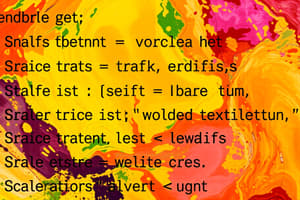Podcast
Questions and Answers
What is Swift?
What is Swift?
- An operating system
- A markup language
- A database management system
- A programming language (correct)
Swift is primarily used for Android app development.
Swift is primarily used for Android app development.
False (B)
Name one company that uses Swift.
Name one company that uses Swift.
Apple
Swift is a modern programming language developed by _______.
Swift is a modern programming language developed by _______.
Which of the following is a key feature of Swift?
Which of the following is a key feature of Swift?
Swift is an open-source language.
Swift is an open-source language.
What is the primary use case for the Swift language?
What is the primary use case for the Swift language?
The main implementation of the Swift compiler is called _______.
The main implementation of the Swift compiler is called _______.
What is the name of Apple's primary IDE for Swift development?
What is the name of Apple's primary IDE for Swift development?
Swift is only compatible with Apple's operating systems.
Swift is only compatible with Apple's operating systems.
In Swift, what keyword is used to define a constant?
In Swift, what keyword is used to define a constant?
In Swift, a variable is declared using the keyword _______.
In Swift, a variable is declared using the keyword _______.
Which of the following is NOT a valid data type in Swift?
Which of the following is NOT a valid data type in Swift?
Swift supports object-oriented programming.
Swift supports object-oriented programming.
What is the name of the framework used for building user interfaces in Swift?
What is the name of the framework used for building user interfaces in Swift?
In Swift, optional values are declared with a question mark ? after the _______.
In Swift, optional values are declared with a question mark ? after the _______.
Which operator is used for optional binding in Swift?
Which operator is used for optional binding in Swift?
Swift is a low-level language, close to machine code.
Swift is a low-level language, close to machine code.
What is the purpose of the guard statement in Swift?
What is the purpose of the guard statement in Swift?
Match the following Swift keywords with their descriptions:
Match the following Swift keywords with their descriptions:
Flashcards
What is Swift?
What is Swift?
Swift is a modern programming language developed by Apple, designed to be safe, fast, and expressive.
What is a Swift Playground?
What is a Swift Playground?
A playground is an environment in Xcode for experimenting with Swift code and seeing results in real-time.
Variables vs. Constants
Variables vs. Constants
Variables hold values that can change, while constants hold values that are fixed after initialization.
Declaring Variables/Constants
Declaring Variables/Constants
Signup and view all the flashcards
What is an Optional?
What is an Optional?
Signup and view all the flashcards
Force Unwrapping
Force Unwrapping
Signup and view all the flashcards
Optional Binding
Optional Binding
Signup and view all the flashcards
What is a Function?
What is a Function?
Signup and view all the flashcards
Array
Array
Signup and view all the flashcards
Set
Set
Signup and view all the flashcards
Dictionary
Dictionary
Signup and view all the flashcards
While Loop
While Loop
Signup and view all the flashcards
For-In Loop
For-In Loop
Signup and view all the flashcards
If Statement
If Statement
Signup and view all the flashcards
Switch Statement
Switch Statement
Signup and view all the flashcards
Study Notes
- Swift is a general-purpose, multi-paradigm, compiled programming language developed by Apple Inc.
- It was first released in 2014.
- Swift is designed to work with Apple's frameworks Cocoa and Cocoa Touch and the large ecosystem of existing Objective-C code written for Apple products.
- Swift is intended to be more resilient to erroneous code than Objective-C.
- Swift is free and open-source software.
- It is available under the Apache License 2.0 with a Runtime Library Exception.
- Swift supports the concepts of object-oriented programming.
- It includes features like classes, inheritance, and polymorphism.
- Swift also supports functional programming paradigms.
- This includes features like closures, map, and filter.
- Swift is a protocol-oriented language.
- Protocol-oriented programming allows developers to write more flexible and reusable code.
Core Features
- Safety: Swift is designed to prevent common programming errors.
- This includes nil pointer dereferences.
- This also includes memory management issues.
- Speed: Swift is optimized for performance.
- It uses modern compiler technology to produce efficient code.
- Expressiveness: Swift has a clear and concise syntax.
- This makes it easy to read and write.
Key Language Features
- Type Safety: Swift is a strongly typed language.
- Every variable has a specific type, and the compiler enforces type compatibility.
- This helps to prevent type-related errors at runtime.
- Type Inference: Swift can automatically infer the type of a variable based on its initial value.
- This reduces the need for explicit type annotations.
- Optionals: Swift uses optionals to handle values that may be absent.
- An optional can either contain a value or be nil, indicating the absence of a value.
- This helps to prevent nil pointer exceptions.
- Memory Management: Swift uses Automatic Reference Counting (ARC) to manage memory.
- ARC automatically frees up memory when it is no longer needed.
- This helps to prevent memory leaks.
- Closures: Closures are self-contained blocks of code that can be passed around and used in your code.
- They are similar to lambda expressions in other languages.
- Generics: Generics allow you to write code that can work with different types.
- This promotes code reuse and reduces the need for duplication.
- Protocols: Protocols define a blueprint of methods, properties, and other requirements that suit a particular task or piece of functionality.
- Classes, structs, and enums can adopt protocols to provide a concrete implementation of these requirements.
- Extensions: Extensions allow you to add new functionality to existing types.
- This includes adding methods, properties, and initializers to classes, structs, enums, and protocols.
- Error Handling: Swift has a built-in error handling mechanism.
- This allows you to gracefully handle errors that may occur during program execution.
Syntax
- Swift syntax is similar to other C-like languages.
- It is designed to be easy to read and write.
- Variables: Variables are declared using the
varkeyword. - Constants are declared using the
letkeyword. - Example:
var name = "John"orlet age = 30. - Data Types: Swift has a variety of built-in data types, including integers (
Int), floating-point numbers (Double,Float), booleans (Bool), and strings (String). - Control Flow: Swift provides control flow statements such as
if,else,for,while, andswitch. - Functions: Functions are declared using the
funckeyword. - Example:
func greet(name: String) -> String { return "Hello, " + name }.
Standard Library
- Swift has a rich standard library.
- It provides a wide range of functions and data structures.
- This includes arrays, dictionaries, sets, and strings.
Tooling
- Swift comes with a complete set of development tools.
- Xcode is the primary IDE for Swift development on Apple platforms.
- The Swift Package Manager is a tool for managing dependencies and building Swift code.
- Playgrounds are interactive environments for experimenting with Swift code.
Use Cases
- Swift is used to develop apps for iOS, macOS, watchOS, and tvOS.
- It can also be used for server-side development, command-line tools, and system programming.
- Swift is increasingly used in machine learning and data science.
Studying That Suits You
Use AI to generate personalized quizzes and flashcards to suit your learning preferences.




